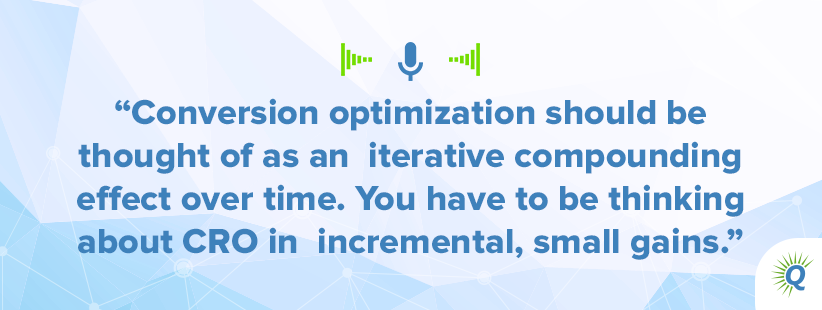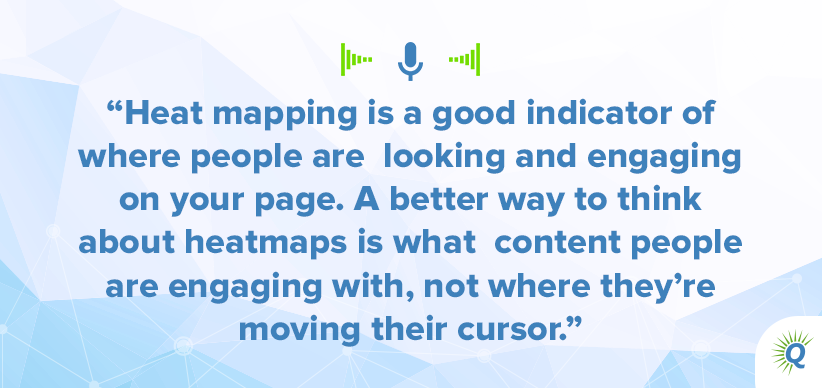Topics:
Never Miss a Beat - Get Updates Direct to Your Inbox
FILTER:


Convert Your Visitors to Buyers with CRO
By Quiet Light
Everybody wants to make more money and spend less money doing it. With proper conversion rate optimization, both are possible. See what The Good’s CEO Jon MacDonald has to say about CRO before you buy or sell your business online. Follow his four steps to badass CRO.
Easton Baseball’s 240% Revenue Increase
CRO to Sell Your Business Online
The Good’s 4 Ingredients for Badass CRO
Whether you’re in the market to sell your business online or you’ve bought a site, you want to get more money for your investment.
You spend a ton of time and funds trying to earn a living from your website. Why not make more money with a few small changes?


CRO, or conversion rate optimization, does just that.
With the right tweaks, you can spike your online revenue. Hell, the best CRO will even decrease your advertising costs. CRO is a real double-whammy for website owners.
In fact, for every $1 you spend on CRO, you get $9 back.
That’s a “Shut up and take my money” kind of number.
And nobody is better at getting that insane ROI than Jon MacDonald, CEO of the CRO firm, The Good.


Jon uses data science to turn his clients’ web traffic into paying customers. And after years in the CRO trenches, Jon has learned a thing or two about improving websites.
Namely, which changes matter for your conversion rates and which changes don’t actually matter.
Jon’s clients often reach out to improve their site before they sell their business online. He also works with many website buyers to get a better return on their investment.
If you want to grow business in the next six months (and you should), it’s time to hop on the CRO train.
In fact, Jon’s got a 4-step framework you can follow for badass CRO, no matter your website, business, or industry.


This ain’t your granny’s CRO
When it comes to business valuations, many people focus on top line revenue.
That’s a bad idea.
The numbers that actually matter are gross profit, your processes, and how you’re optimizing the bottom line.
These things are how people will really valuate your biz.
I mean, profit is great, but if there isn’t a winning strategy behind that profit, you can’t sell your business online for a high asking price.
CRO uses the magic of data science to not only improve your business but increase your potential.


That’s a recipe for a higher valuation and more money in your pocket when you sell your site.
If you’re a buyer, it means you get a better return on your purchase. It’s a win-win no matter if you’re buying or selling.
CRO is about empathy
CRO is primarily concerned with data.
But it’s not just about data for data’s sake. It’s about finding meaning from the data.
“There are so many brands that sign up for CRO platforms to run tests,” Jon says, “They start running tests and just randomly cherry-pick ideas. But they don’t have any hypotheses behind these ideas or data to back them up.”
Please don’t change the color of your CTA buttons or rewrite your headlines and call it CRO.
These small changes do have a positive effect on your site, but CRO is about balancing small and big changes to move the needle.
IMAGE SUGGESTION: https://www.shutterstock.com/image-vector/b-comparison-split-testing-isometric-concept-1084926965
At the end of the day, CRO is about having empathy for your user.
According to Jon, good CRO means:
You understand your site thanks to data. And that means you need at least 3-6 months’ worth of data to make better decisions.
You know which metrics matter to your business.
You make changes to your site according to your data and metrics.
See what users are doing, what they’re not doing, and how they engage with your site with proper CRO.
But CRO is just about conversions. CRO covers everything from average order value to cart abandonment to ROAS.
CRO is a sexy process.
It’s a practice at the intersection of data science, technical skill, and creative prowess.
Because CRO is such an integrated practice, it’s hard to find someone with these three skills to optimize your site.
That’s why it’s so hard to find a quality CRO expert. But once you find them, don’t you dare let go. CRO can quite literally transform your business in just a few months.
![Quote from the podcast: When you’re buying an eCommerce company, the first thing you’re looking to do is optimize the return on the investment you just made.]](https://quietlight.com/wp-content/uploads/2019/07/podcast-quote-graphic-4-1.png)
![Quote from the podcast: When you’re buying an eCommerce company, the first thing you’re looking to do is optimize the return on the investment you just made.]](https://quietlight.com/wp-content/uploads/2019/07/podcast-quote-graphic-4-1.png)
Everybody needs CRO
QuietLight’s founder, Mark, hired a CRO expert at $2,000 a month to optimize a venture he was working on.
Mark used CRO to overhaul his lead gen signup process. It was free for users to sign up, but Mark knew that the value of each signup was $10.
$2,000 is a hefty investment, but guess what? Mark saved $6,000 in advertising costs alone with CRO.
With CRO, Mark increased the number of signups and decreased his customer acquisition costs.


The thing about CRO is that it doesn’t just increase your earnings. It also cuts costs.
It’s a double-whammy! Get more money and spend less doing it. What more could you want?
It won’t happen overnight, but give a CRO pro a few weeks with your site to see big changes.
Your traffic won’t change, but your revenue will. If you’re concerned about earning more without looking for more traffic, CRO is right up your alley.
Easton Baseball’s 240% revenue increase
Jon’s client, Easton Baseball, put CRO to the test on their website.
If you aren’t familiar with Easton, they manufacture aluminum baseball bats. Many of their bats are used in Little League games.
But Easton had a problem.


Customers were frequently frustrated with the website. Their products had a high return rate and there were plenty of angry calls to customer service.
After conducting tests, Jon realized Easton’s problem.
Their product page was a wall of bat pictures. Little League parents had no idea what to buy, so they bought the nicest bats they could find.
Their children showed up to practice with bats that weren’t Little League-approved, which meant little Johnny had to sit on the bench and Mommy had to return his bat.
Easton’s site also used branded terms that, while they sounded cool, they meant nothing to outsiders.
The Good fixed these problems by setting up a Bat Finder, which asks customers a few questions before suggesting 3-4 bats for purchase.
They adjusted the terminology on the site to be more generic and easy to understand.


As a result of these two fixes, Easton saw a 240% increase in year over year revenue. Yes, 240%.
I had to check that number twice because I couldn’t believe it, either.
240%? I want in!
Easton’s conversion rate increased by 187%, too.
They eventually sold to a private equity firm, where they got a very good ROI.
With numbers like these, biz owners should be hiring CRO experts like mad.
So … why aren’t they?
If CRO has such an amazing ROI, why aren’t more people doing it?
If people are seeing 9x returns, why aren’t we forking over more cash for CRO?
The short answer is that we don’t want to put in the work.


You have to make changes with CRO. You have to collect and analyze data. You have to do user testing.
It’s complicated and has a lot of moving parts.
IMAGE SUGGESTION: https://www.shutterstock.com/image-vector/lead-generation-flat-isometric-vector-concept-1043111470
You can’t use out of the box software like Google Analytics to do CRO right. Just the process of getting good data is an art by itself.
The thing is, website owners need to get over this aversion to CRO.
As we’ve seen with Mark’s experiences and Easton Baseball, CRO is really freakin’ powerful.
Earn the money you deserve and prove your business is worth more with CRO. It’s time to saddle up and make changes to get the revenue you deserve.
CRO to sell your business online
Let’s say you’re preparing to sell your business online.
One of the first things many sellers do is shell out thousands to get more traffic to the site.
Because more traffic equals better earnings, right?
And better earnings mean a higher valuation.
And that means more money in your pocket, Daddy Warbucks.
But actually, this isn’t how website owners should be operating.


Traffic isn’t the problem
Your site should already have enough traffic coming to it, especially if someone is already interested in buying it.
Jon works with a lot of clients at The Good because they fall into this trap: they spend money to get traffic to their site, but aren’t seeing return on ad spend, or ROAS.
It’s not much of a different story if you’ve bought a website, either. You need to see positive cash flow on your investment, and fast.
That means you need to bring more people on-site to buy your stuff.


The good news is that no matter your situation, CRO gives returns in hard numbers that everyone will love.
But let’s look beyond changing the color of your buttons. Let’s be more imaginative than split-testing copy.
Follow Jon’s advice to see wicked returns on your investment, whether you’re buying or selling a business.
The Good’s 4 ingredients for badass CRO
Jon follows a four-step framework to help his clients’ conversions go from “meh” to “miraculous” in a few months.
Google Analytics
If you want to sell your business online, your buyer will want to dive headfirst into your Analytics.
But this is where well-intentioned CRO hits a snag. Google Analytics data isn’t helpful right out of the box.
Jon says brands need to set up custom dashboards to get information that’s actually useful.
Otherwise, you’ll show a buyer a meaningless wall of data that won’t boost your value.
The right dashboard setup depends on the type of business you have. For content-based sites (and all sites, really), you can use one readymade dashboard in Google Analytics.
Users Flow is a visual representation of how people travel through your site.


It’s a horrible, ugly, and complicated chart that’s overwhelming to look at.
And that’s why so few people use this dashboard, although it has great insights for CRO. But don’t lose faith; learn how to interpret this chart to have better empathy for your users.
You’ll want to use custom dashboards in Google Analytics if you have an eCommerce or SaaS site.
Data dashboards for eCommerce
You can still use Google Analytics to monitor your eCommerce site, but you have to set it up right.
First of all, please don’t forget to tell Google Analytics to track eCommerce data. Your data will be wonky from the start if you don’t tell Analytics that you have an eCommerce site.
Make sure you put Google event tracking to work on your site.
But don’t fall into the trap of only considering conversions as events. Customers take plenty of actions on your eCommerce site before they convert.
Measure those actions (called micro conversions) to see a customer’s path to purchase.
For example, if you sell shoes online and set up Event tracking, you would notice that customers are more likely to convert when they read reviews or check size charts.
Using this data, you could move these features higher on the page, bringing more users into your conversion funnel.
Boom, just like that.


Data dashboards for SaaS
No matter how you slice it, the purpose of a SaaS website is lead gen.
When you’re concerned with lead gen, your Analytics needs to pick up better data on form completions.
While you can track submissions through URL tracking, you’ll get better data pairing Analytics with Google Tag Manager.
But gathering SaaS data is easier said than done. The data only shows one side of the story.
In his work with The Good, Jon works with clients who think they have their SaaS positioning nailed down.
“But when people visit the home page, they have no idea what the company’s value is,” Jon says.
Google Analytics data might tell you that your lead forms aren’t working.
Maybe the form has too many fields or displays weird. It’s up to your CRO pro to distill the reasons why.

Site interaction
A quality CRO won’t make snap decisions after interpreting your data.
They take the extra step of looking at your site interaction data for a well-rounded view of your user experience.
Jon likes to use scroll maps, eye tracking, and heatmap tools to monitor user engagement on a website.
Scroll maps show how far down the page your users go. Eye tracking determines what people are looking at, and for how long.


The tech sounds a little spooky, but it’s all in the name of building a better website.
Heatmaps are perfect to see where people are clicking on your site.
“Are people clicking on something that isn’t actually clickable?” Jon says, “That’s a good indicator you need to change something.”
Clicks = attention
But it’s important to remember that heatmaps aren’t about clicks. They’re indicative of where people are engaging with your website.
Instead of focusing on the number of clicks you’re getting, see what content people are engaging with on the site.
Is there a piece of content, like a button, that people click every time they make a purchase? If so, slap that content to the top of the page to get more conversions.


While these tools aren’t going to tell you the whole story, they can help you test assumptions to build a badass website with CRO.
Hotjar ($89/mo) and Crazy Egg ($24/mo) are some of the best site interaction CRO tools.
For a little over a hundred bucks a month you get two of the most powerful CRO tools on the market. That’s not a shabby investment.
User testing
Tools like Google Analytics and heatmaps will help you build a scrap heap of data.
Now it’s time to refine that scrap heap into squeaky, shiny, actionable ideas.
While there’s a lot of value for quantitative data in CRO, sometimes you need to look at that data with a qualitative lens.


Machines can tell us a page is performing poorly, but they can’t tell us why that’s happening.
That’s why Jon recommends website owners have user testing on their site.
Jon picks users that are in his clients’ target audience. He then trains these users to be slick, website-critiquing ninjas to get better feedback.
“While the users are completing the tasks we give them, they’re recording their screen and audio. We’ve trained these people ahead of time to talk about the experience that they’re having,” Jon says.


Don’t make it weird
Want successful user testing?
Don’t be creepy, according to Jon.
It’s tempting to bring users into your office and watch them navigate the site, but you won’t get good data that way.
“The best user testing happens when it’s remote and unmoderated,” Jon says.
Rely on sources like UserTesting to connect with website testers.
Often you’ll get feedback that coincides with the numerical data you’ve collected.
The difference is that you get the context behind your data and know why something is happening.
If users aren’t buying your snap-on hairpieces, user testing might reveal that your “Buy” button is too far down on the page.
You get the qualitative feedback that backs up your data that the site isn’t converting well.
Finally, you have an idea of what to fix!


If you plan to sell your business online, don’t neglect user testing. This step alone will glean a lot of insight to boost your website’s value.
After looking at the quantitative and qualitative data, you’ll get an idea of what you need to adjust on your site.
Split testing
Remember learning the scientific method in elementary school?
The final step of CRO is putting the scientific method to work on your site with split testing.
Split testing, or A/B testing, is about displaying different elements of your site to separate segments of website users. You measure the data to see which test performed better.


So if 100 people came to your site, you would display your unchanged page to 50 users, while the other 50 saw the test page. You would review the results in your Analytics account to determine which test was more successful.
Split testing can be as granular as testing the color of a button on the page, or as big as displaying different landing pages.
Testing is great because user actions inform what you need to change, instead of taking a wild stab in the dark.
A warning
But here’s the thing about split testing.
Jon sees it all the time with his clients: their website isn’t performing, so they jump straight to split testing to see what they need to improve.
That’s a noble mindset, but you’re skipping the first steps (Analytics, interaction tools, user testing) and jumping right to the testing.


This is a good way to test the wrong elements and lose money.
Don’t sign up for split testing software before you know what questions to ask.
Also, some website owners will try split testing when their site is still too small.
Remember, you need a healthy dose of traffic to make your money back on split testing. “You need traffic to see statistically significant results,” Jon warns.
Split testing tools
If you don’t have a lot of traffic right now, that’s okay.
This is a common predicament when you’ve bought a website and you’re trying to scale it.


Google Optimize is a good way to do split testing on all sites, including those with trickles of traffic.
Google Optimize integrates with Analytics and can even pull segments from your Analytics account for split tests.
Best of all, it’s free!
However, if you have a tiny site, you’ll have to run bigger tests at first.
“Instead of testing button colors or headers, you need to test entire pages of content,” Jon says. This will get you better results.
And don’t worry. You can get more nitpicky with split tests as your traffic grows.
Remember that this free tool does have limitations. You can only run a number of tests at the same time.
If you have decent traffic to your site, Visual Website Optimize ($149/mo) is a good place to start.


For gigantic, enterprise-level websites, Optimizely is your best bet. With a monthly cost of $10,000, though, it’s big-league software.
The upside is that you get a lot for your money. You can optimize for every experience, including mobile, app, and web.
What’s underneath your data?
CRO is about driving meaningful change for your brand. We can’t begin the transformation until we look at our data.
Jon recommends starting with your data first and working from there. “Set aside one hour a week on your calendar to look at your data. Over time, you’ll notice trends,” he says.
Patterns and trends help us have more empathy for the people using our websites.
But even then, it’s not enough to rely on the ones and zeroes in our Analytics account.
As Jon puts so poignantly: “It’s hard to read the label from inside the jar.”


It’s easy to make a website. But designing a website that’s built not for yourself, but for your users, is hella hard.
Good CRO isn’t about your data. It’s about the questions beneath that data. Never stop looking for questions and you’ll find better answers.
And if you don’t get the answers you want? That’s okay!
“When a test doesn’t have the outcome that we want here at The Good, we don’t call it a failure. We call it a learner,” Jon says.
At its core, CRO is about learning. Curiosity will influence what you’re testing and how you grow.
Whether you want to buy or sell your business online, CRO will improve more than your conversions.
It totally transforms the customer experience, fortifying your profits in the process.
Isn’t it time to quit struggling? Embrace CRO to build your badass brand empire.





